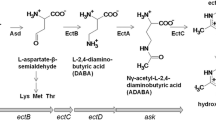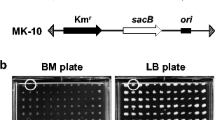Abstract
The focal point of phenylalanine biosynthesis is a dehydratase reaction which in different organisms may be prephenate dehydratase, arogenate dehydratase, or cyclohexadienyl dehydratase. Gram-positive, Gram-negative, and cyanobacterial divisions of the eubacterial kingdom exhibit different dehydratase patterns. A new extremehalophile isolate, which grows on defined medium and is tentatively designated as Halobacterium vallismortis CH-1, possesses the interlock type of prephenate dehydratase present in Gram-positive bacteria. In addition to the conventional sensitivity to feedback inhibition by l-phenylalanine, the phenomenon of metabolic interlock was exemplified by the sensitivity of prephenate dehydratase to allosteric effects produced by extra-pathway (remote) effectors. Thus, l-tryptophan inhibited activity while l-tyrosine, l-methionine, l-leucine, and l-isoleucine activated the enzyme. l-Isoleucine and l-phenylalanine were effective at μM levels; other effectors operated at mM levels. A regulatory mutant selected for resistance to growth inhibition caused by β-2-thienylalanine possessed an altered prephenate dehydratase in which a phenomenon of disproportionately low activity at low enzyme concentration was abolished. Inhibition by l-tryptophan was also lost, and activation by allosteric activators was diminished. Not only was sensitivity to feedback inhibition by l-phenylalanine lost, but the mutant enzyme was now activated by this amino acid (a mutation type previously observed in Bacillus subtilis). It remains to be seen whether this type of prephenate dehydratase will prove to be characteristic of all archaebacteria or of some archaebacterial subgroup cluster.
Similar content being viewed by others
References
Ahmad S, Jensen RA (1988) New prospects for deducing the evolutionary history of metabolic pathways in prokaryotes: aromatic biosynthesis as case-in-point. Origins of Life 18:41–57
Bayley ST, Morton RA (1978) Recent developments in the molecular biology of extremely halophilic bacteria. CRC Crit Rev Microbiol 6:151–205
Berry A, Ahmad S, Liss A, Jensen RA (1987) Enzymological features of aromatic amino acid biosynthesis reflect the phylogeny of mycoplasmas. J Gen Microbiol 133:2147–2154
Bradford MM (1976) A rapid and sensitive method for the quantitation of microgram quantities of protein using the principle of protein-dye binding. Anal Biochem 72:248–254
Byng GS, Kane JF, Jensen RA (1982) Diversity in the routing and regulation of complex biochemical pathways as indicators of microbial relatedness. CRC Crit Rev Microbiol 9:227–252
Coats JH, Nester E (1967) Regulation reversal mutation: characterization of end-product activated mutants of Bacillus subtilis. J Biol Chem 242:4948–4955
Cotton RGH, Gibson F (1965) The biosynthesis of phenylalanine and tyrosine: enzymes converting chorismic acid into prephenic acid and their relationship to prephenate dehydratase and prephenate dehydrogenase. Biochim Biophys Acta 100:76–88
Dayan J, Sprinson DB (1970) Preparation of prephenic acid. In: Tabor H, Tabor CW (eds) Methods in enzymology, vol 17A. Academic Press, New York, pp 559–561
Fazel AM, Jensen RA (1980) Regulation of prephenate dehydratase in coryneform species of bacteria by l-phenylalanine and by remote effectors. Arch Biochem Biophys 200:165–176
Fischer R, Jensen RA (1987a) Metabolism of aromatic amino acids and amines. In: Colowick SP, Kaplan NO (eds) Methods in enzymology, vol 142, chap 61 Prephenate dehydratase (monofunctional). Academic Press, Orlando, FL, pp 507–512
Fischer R, Jensen RA (1987b) Metabolism of aromatic amino acids and amines. In: Colowick SP, Kaplan NO (eds) Methods in enzymology, vol 142, chap 59, Arogenate dehydratase. Academic Press, Orlando, FL, pp 495–502
Hall GC, Flick MB, Gherna RL, Jensen RA (1982) Biochemical diversity for biosynthesis of aromatic amino acids among the cyanobacteria. J Bacteriol 149:65–78
Jensen RA (1969) Metabolic interlock: Regulatory interactions exerted between biochemical pathways. J Biol Chem 244:2816–2823
Jensen RA (1976) Enzyme recruitment in evolution of new function. Ann Rev Microbiol 30:409–425
Jensen RA (1985) Biochemical pathways can be traced backward through evolutionary time. Mol Biol Evol 2:92–108
Jensen RA, Fischer R (1987) Metabolism of aromatic amino acids and amines. In: Colowick SP, Kaplan NO (eds) Methods in enzymology, vol 142, chap 56, The post-prephenate biochemical pathways to phenylalanine and tyrosine. Academic Press, Orlando, FL, pp 472–478
Kurahashi O, Yokozeki K, Yamanaka S, Enei H (1986) Effect of l-phenylalanine and l-methionine on the appearance of l-tryptophan-producing mutants of Bacillus subtilis K. Agric Biol Chem 50:3211–3212
Lake JA, Clark MW, Henderson E, Fay SP, Oakes M, Scheinman A, Thornber JP, Mah RA (1985) Eubacteria, halobacteria, and the origin of photosynthesis: the photocytes. Proc Natl Acad Sci USA 82:3716–3720
Pierson DL, Jensen RA (1974) Metabolic interlock: Control of an interconvertible prephenate dehydratase by hydrophobic amino acids in Bacillus subtilis. J Mol Biol 90:563–579
Rebello JL, Jensen RA (1970) Metabolic interlock: The multimetabolite control of prephenate dehydratase activity in Bacillus subtilis. J Biol Chem 215:3738–3744
Riepl RG, Glover GI (1978) Purification of prephenate dehydratase from Bacillus subtilis. Arch Biochem Biophys 191:192–197
Riepl RG, Glover GI (1979) Regulation and state of aggregation of Bacillus subtilis prephenate dehydratase in the presence of allosteric effectors. J Biol Chem 254:10321–10328
Rodrigeuz-Valera F, Ruiz-Berraquero F, Ramos-Cormenzana A (1980) Isolation of extremely halophilic bacteria able to grow in defined inorganic media with single carbon sources. J Gen Microbiol 119:535–538
White BN, Bayley ST (1972) Further codon assignments in an extremely halophilic bacterium using a cell-free proteinsynthesizing system and a ribosomal binding assay. Can J Biochem 50:600–609
Woese CR (1973) Evolution of the genetic code. Naturwissenschaften 60:447–459
Woese CR (1987) Bacterial evolution. Microbiol Rev 51:221–239
Ycas M (1974) On earlier states of the biochemical system. J Theor Biol 44:145–160
Author information
Authors and Affiliations
Rights and permissions
About this article
Cite this article
Jensen, R.A., d'Amato, T.A. & Hochstein, L.I. An extreme-halophile archaebacterium possesses the interlock type of prephenate dehydratase characteristic of the Gram-positive eubacteria. Arch Microbiol 149, 365–371 (1988). https://doi.org/10.1007/BF00411657
Received:
Accepted:
Issue Date:
DOI: https://doi.org/10.1007/BF00411657




